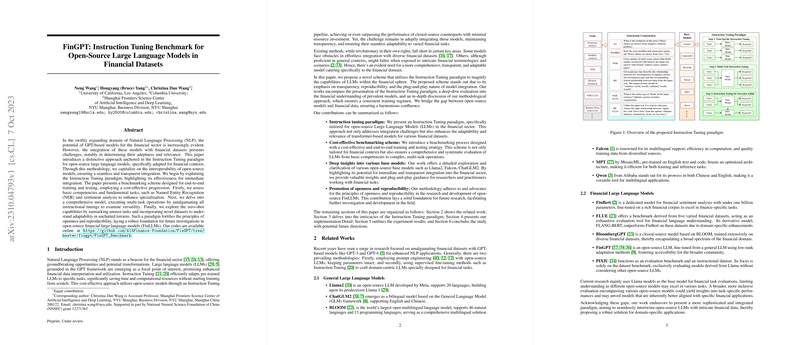FinGPT: Instruction Tuning Benchmark for Open-Source LLMs in Financial Datasets
The paper, "FinGPT: Instruction Tuning Benchmark for Open-Source LLMs in Financial Datasets," presents an innovative methodology for enhancing LLMs using the Instruction Tuning paradigm, explicitly designed to address challenges within the financial sector. This work is structured around improving the interoperability and adaptability of open-source LLMs in financial contexts, underscoring the necessity for transparent and reproducible model integrations.
Overview of Contributions
The research identifies several core contributions:
- Instruction Tuning Paradigm: The authors propose an Instruction Tuning paradigm tailored for open-source LLMs in finance. This approach addresses integration challenges, enhancing the adaptability and relevance of transformers for diverse financial datasets.
- Cost-effective Benchmarking: A benchmarking process for end-to-end training and testing is developed, focusing on efficiency. This integrates basic competencies like Named Entity Recognition (NER) and sentiment analysis, before advancing to more complex multi-task operations.
- Deep Insights into Base Models: Detailed insights into various open-source base models, such as Llama2, Falcon, ChatGLM2, are provided, demonstrating their adaptability and integration into financial tasks.
- Promotion of Openness and Reproducibility: The paper champions openness, providing a robust foundation for future research in open-source financial LLMs (FinLLMs).
Methodology and Experimentation
The proposed paradigm is methodically divided into three phases:
- Task-Specific Instruction Tuning: Here, LLMs are evaluated based on foundational competencies for individual financial NLP tasks. This phase identifies areas where models excel or require improvements.
- Multi-Task Instruction Tuning: This phase evaluates LLMs' versatility by amalgamating various instructional tunings, mimicking the multitasking nature of the financial sector.
- Instruction Tuning for Zero-shot Capability: The final phase enhances LLMs' ability to adapt to unseen tasks, emphasizing robustness and flexibility in novel financial contexts.
Technical Results
The experimentation covers six open-source LLMs, each subjected to the Instruction Tuning paradigm. Key findings from the experiments include:
- Task-Specific Performance: Llama2 delivered superior results, evidenced by its average ranking across tasks. While models like Falcon and BLOOM showed varied strengths, each manifested unique potential within specific task domains.
- Multi-Task Learning: The introduction of a multi-task learning environment generally improved performance in information extraction tasks, particularly for models like Llama2 and MPT.
- Zero-shot Proficiency: Models like ChatGLM2 and Falcon demonstrated noteworthy zero-shot performance, indicating robust generalization capabilities even when not excelling in earlier phases. This highlights the models' potential to adapt and execute high-level financial tasks without explicit retraining.
Implications and Future Directions
The implications of this research are significant for the financial domain and NLP research. Practically, the use of these open-source models can streamline financial data processing tasks, providing accurate and adaptable solutions. Theoretically, the openness and reproducibility of this benchmark pave the way for more refined and specialized financial LLMs.
Future research should explore incorporating larger-scale models, enhancing the robustness of LLMs against task interference and hallucinations, and broadening the evaluation metrics to better align with real-world financial applications. Emphasis on partnerships with financial institutions could drive practical implementations, ensuring the models meet industry needs.
Conclusion
The paper's comprehensive exploration and synthesis of Instruction Tuning for financial LLMs establish a foundational benchmark for future investigations. By thoroughly examining model capabilities and integrating innovative instructional strategies, it addresses current gaps, promoting a more adaptable and open approach to financial data processing in the NLP domain.
